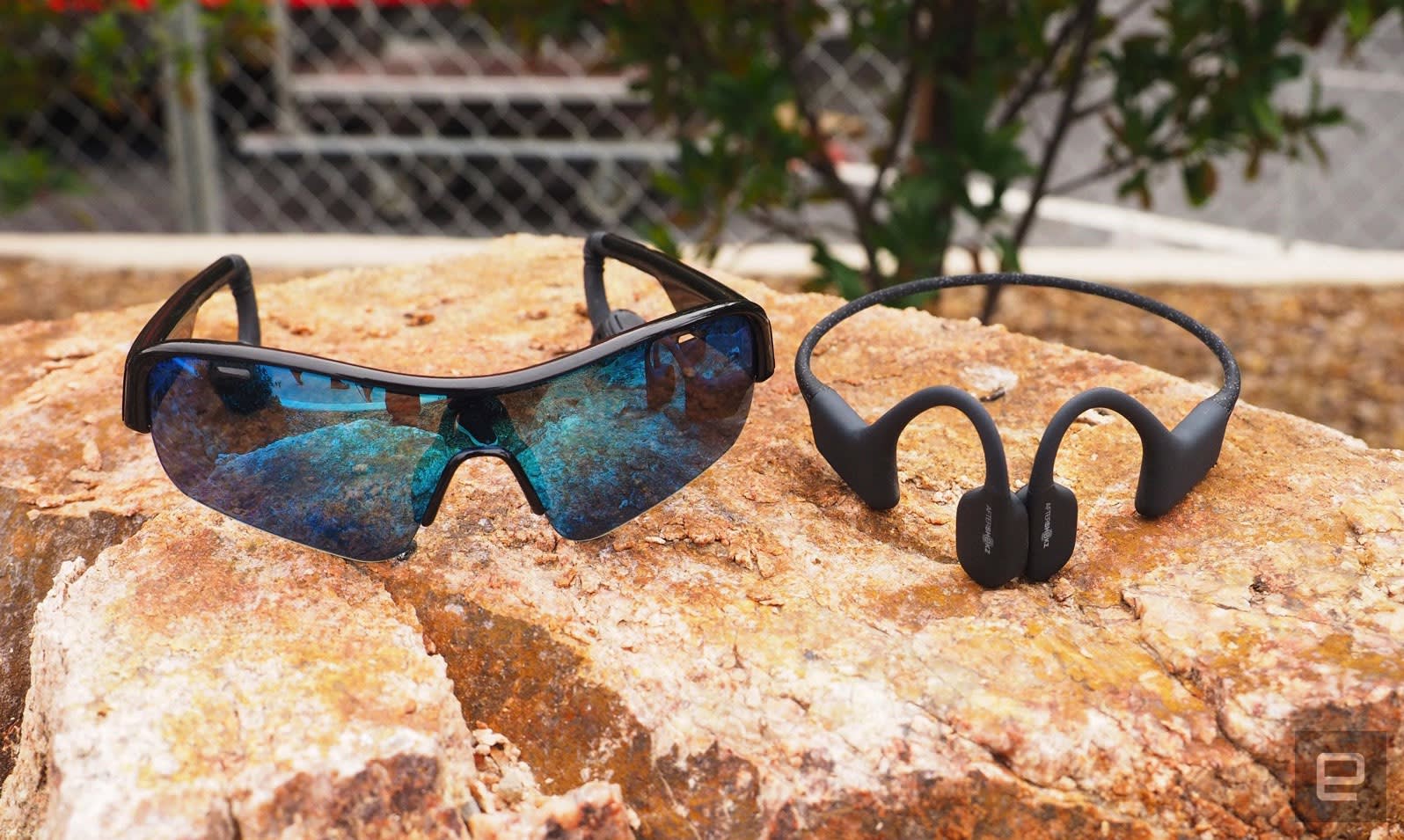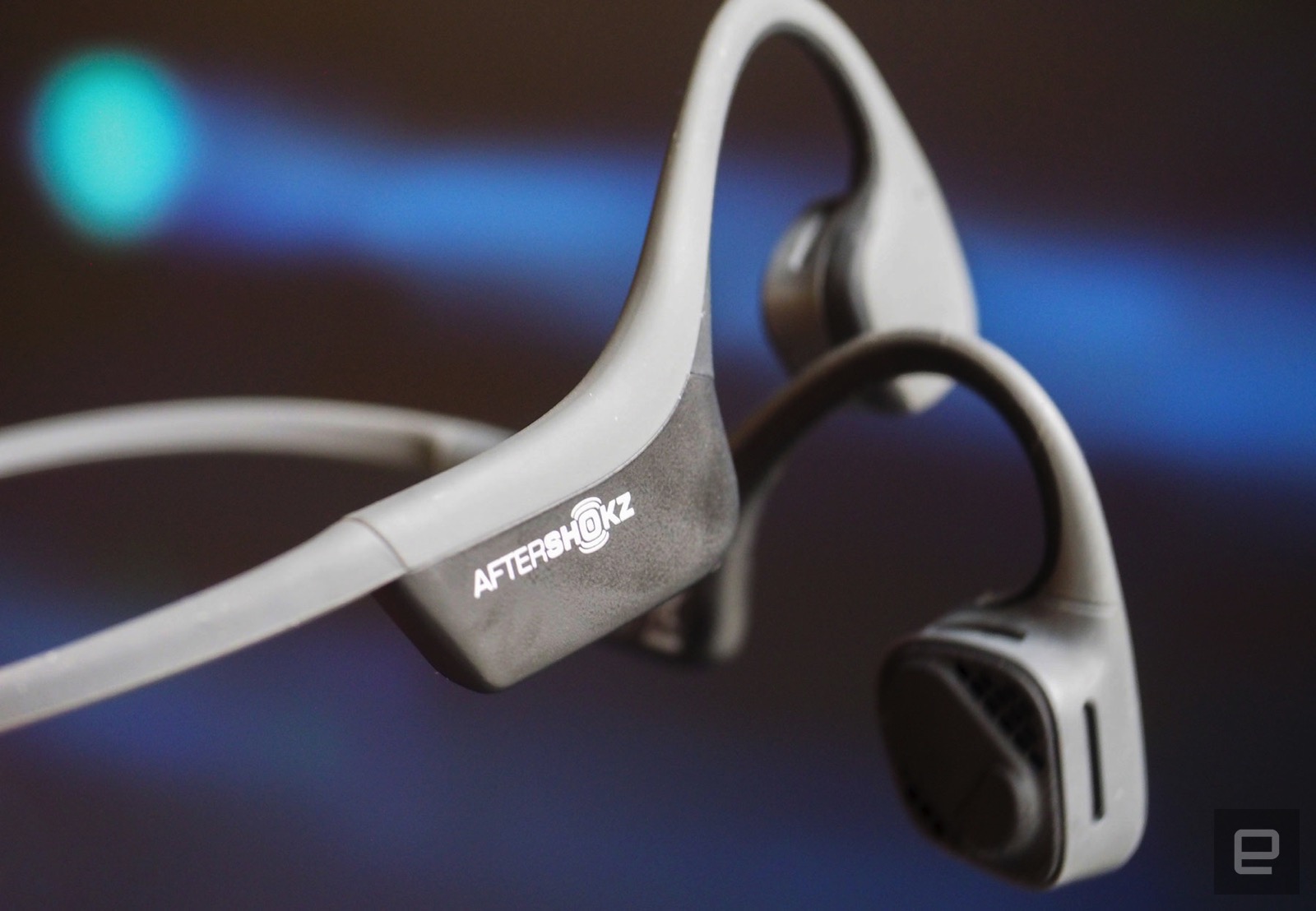
This year, Panasonic's pretty much gone all out with a vast range of gadgets. Tablets, TVs, Touch Pens, cameras, and outrageous Hi-Fi. One smaller addition to the company's portfolio was a pair of bone conducting Bluetooth headphones. The technology isn't exactly new, but as more and more companies get onboard, they start edging their way into the mainstream. Panasonic's take on them looks -- at least initially -- like a good start. At first, the design looks almost like any other wrap-around pair of sports headphones. Until, of course, you inspect closer, and realise that there aren't actually any buds to place in your ears. The soft-touch outer material around the ear-hooks makes them feel nice in the hand, and adds to the sporty look. Unusually they are powered by a single AAA battery, that you sneak into the slightly bulbous section in the middle of the band. We were told, however, that this might change to a rechargeable solution when we get closer to the projected fall release window.
We were eager to see how the audio performed, but it's fair to say that on a rowdy show floor this was pretty difficult. We were advised to put our fingers in our ears to initially hear the music, and then remove them while focusing on the music. In reality, even with ears fully plugged, hearing the demo song was pretty difficult. With ears fully open to the ambient noise, we couldn't hear anything at all. The representative was sure to advise us that production models would be two to three times louder, and we'd go as far to say that even that might not be enough. One thing is for sure, they did definitely work, and the effect is still impressive. The product is pitched at more active use cases though, so it will be interesting to see how they work while on the move / run. Again, something that was a little difficult for us to explore, despite really wanting to. As stated above, these should see the light of day sometime in fall, and we really do hope they are louder. Price-wise, there's no official word, but if you imagine $200 as a ballpark figure, you might not be too far off the mark.
Billy Steele contributed to this report.
Filed under: Home Entertainment
Comments
 Keeping your ears open to the environment is key when riding a bike or otherwise needing to stay aware of your surroundings, but music is life right? The AfterShokz Trekz Titanium and Air series have been filling that need quite well for a while, but...
Keeping your ears open to the environment is key when riding a bike or otherwise needing to stay aware of your surroundings, but music is life right? The AfterShokz Trekz Titanium and Air series have been filling that need quite well for a while, but...
 Keeping your ears open to the environment is key when riding a bike or otherwise needing to stay aware of your surroundings, but music is life right? The AfterShokz Trekz Titanium and Air series have been filling that need quite well for a while, but...
Keeping your ears open to the environment is key when riding a bike or otherwise needing to stay aware of your surroundings, but music is life right? The AfterShokz Trekz Titanium and Air series have been filling that need quite well for a while, but...
 When Aftershokz released its Trekz Titanium bone-conduction headphones, there was a marked change from the Bluez 2 line before it. The design shifted from a stiff plastic headband to a ruggedly flexible and sportier design. Today at IFA in Berlin, th...
When Aftershokz released its Trekz Titanium bone-conduction headphones, there was a marked change from the Bluez 2 line before it. The design shifted from a stiff plastic headband to a ruggedly flexible and sportier design. Today at IFA in Berlin, th...
 While modern Bluetooth earpieces are more compact than ever, chances are you'll still need to leave at least one stuck in your ear. This can get uncomfortable over time, not to mention the dorkiness that's been haunting this form factor since day one...
While modern Bluetooth earpieces are more compact than ever, chances are you'll still need to leave at least one stuck in your ear. This can get uncomfortable over time, not to mention the dorkiness that's been haunting this form factor since day one...
 Today on In Case You Missed It: The SIGNL strap Kickstarter campaign wants to put a private phone speaker at the tip of your finger. Plus, Japan combines its two favorite past times -- the graceful art of sumo and autonomous robots -- into a kickas...
Today on In Case You Missed It: The SIGNL strap Kickstarter campaign wants to put a private phone speaker at the tip of your finger. Plus, Japan combines its two favorite past times -- the graceful art of sumo and autonomous robots -- into a kickas...
 Today on In Case You Missed It: Local Motors is testing a self-driving, electric mini-bus that lets passengers communicate with the bus about the weather and where they're located as they are shuttled from one part of town to another. The bus was...
Today on In Case You Missed It: Local Motors is testing a self-driving, electric mini-bus that lets passengers communicate with the bus about the weather and where they're located as they are shuttled from one part of town to another. The bus was...
 Researchers looking for a better way to secure their face computers have come up with a novel solution for hands-free, head-mounted password entry. A device could potentially identify its wearer by emitting an ultrasonic hum through their skull and l...
Researchers looking for a better way to secure their face computers have come up with a novel solution for hands-free, head-mounted password entry. A device could potentially identify its wearer by emitting an ultrasonic hum through their skull and l...
 In 2011, Microsoft UK teamed up with charity Guide Dogs to create 'Cities Unlocked,' an organization that worked to create a headset designed to help the visually impaired. That device came last year, but now it's received some major hardware and sof...
In 2011, Microsoft UK teamed up with charity Guide Dogs to create 'Cities Unlocked,' an organization that worked to create a headset designed to help the visually impaired. That device came last year, but now it's received some major hardware and sof...
 Long bike rides are an easy way to burn calories without terrorizing your knees, but it helps to have some tunes to keep things fun. My rides usually take me through bustling urban streets and isolated stretches of waterfront, so pumping out a soun...
Long bike rides are an easy way to burn calories without terrorizing your knees, but it helps to have some tunes to keep things fun. My rides usually take me through bustling urban streets and isolated stretches of waterfront, so pumping out a soun...

